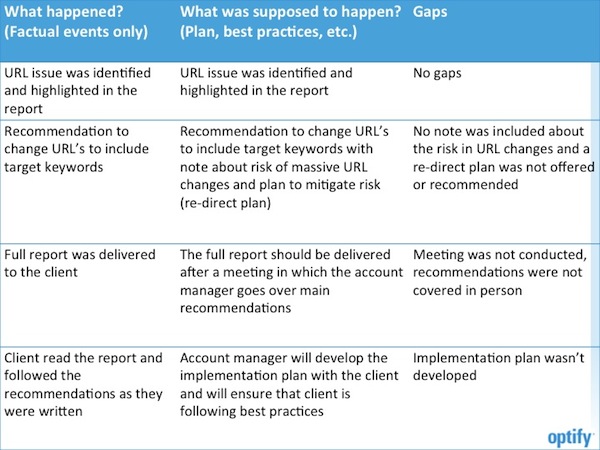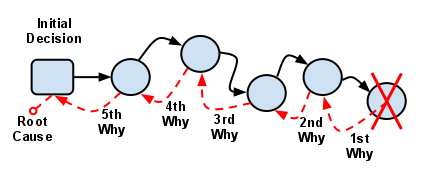While I was scrambling to finish some last-minute handover items during my last day in the office before heading on vacation, I remembered a saying we had in the army: “A good commander is tested in his absence.”
Basically, this mantra forces you to ask yourself if you’ve prepared your team well enough to keep everything running smoothly even when you aren’t there. Did you train them well enough to trust them to do their work even when you aren’t hovering over their shoulder to make sure that every detail is in place?
This is a question that every manager should ask, and it touches on one of the core elements of management: coaching. It’s the ability to make the people around you better because it makes the entire organization better.
Whether you’re managing a marketing team, a company, or an agency, the only way to truly succeed (and scale) is to make sure you empower your team enough to do the job – even in your absence.
One of the ways to do that is to use any opportunity to analyze their performance in executing the tasks you assigned to them. If you look close enough, there are multiple opportunities like that every day.
Finding Coaching Opportunities
 For example, let’s say that you run an SEO agency and one of your basic services is on-page SEO analysis. Since it’s a relatively simple and somewhat repetitive task, you assign it to one of your junior account managers. You show him how to use the software to get the information about the page, how to create the report and how to send it to the client.
For example, let’s say that you run an SEO agency and one of your basic services is on-page SEO analysis. Since it’s a relatively simple and somewhat repetitive task, you assign it to one of your junior account managers. You show him how to use the software to get the information about the page, how to create the report and how to send it to the client.
A week later you get an angry call from one of your new clients telling you that his ranking on one of the keywords dropped from position 15 to “off-the-grid.” He blames your on-page recommendations for that drop.
After you talk your client off the cliff, you take a closer look at the report your junior manager created. You notice that he highlighted an issue with the client’s URL structure and the fact that the URLs don’t include any of the target keywords. He recommended changing the URLs to include the target keywords, and the client, following these instructions, immediately changed the URLs without any redirect work to ensure that links to the old URL continue sending visitors to the right page.
Who’s to Blame?
You can obviously blame your account manager – or even fire him if you want to be extreme. You can blame the client. And you can blame yourself.
But is it really about blame? Wouldn’t it be better to leverage this opportunity to learn something about your operation and teach your account manager something that will make him better?

Performance Analysis Framework
The following framework simple but extremely powerful in identifying the actual gaps in performance and providing simple direction on how to solve these gaps and drive for improvements.
The concept is simple: you identify the gaps between what happened and what was supposed to happen by comparing them step by step. You then categorize and prioritize the gaps and outline the simple ways to mitigate them in the future.
The trick in this framework is to start by accurately framing the event you want to analyze. This will be important to keep the scope of the analysis within reason and also to avoid confusion in terms of the sequence of events.
You should also stick to comparing only factual events with the plan and ignore subjective “non-events” like what the person thought, felt, or was planning to do. Those would come at a later point.
Example:
- Event: Client changed URLs to include target keywords without following a redirect plan.
- Time frame: From the time the report was conducted and delivered to the client, to the time the client changed the URLs.

Categorizing and Prioritizing Gaps
There are three categories of performance gaps:
- Knowledge
- Execution
- Philosophy/concept
Gaps in knowledge are simple to fix. They just require teaching or developing that knowledge. For example, if the account manager doesn’t know what a redirect plan is, you need to make sure that you teach him or that you direct him to where he can learn about it.
Gaps in execution might be a little harder to solve, but most of the time the solution is practice.
For example, when analyzing why a recommendation for a redirect plan wasn’t given, you might discover that a plan was actually outlined but was poorly communicated. This means that you need to work with your account manager on his presentation and/or communication skills. The best solution for that would be to have him practice multiple times in front of you and your colleague before you let him present on his own to a client. You might also realize that the execution gap is so severed that he shouldn’t be presenting to clients at all.
Gaps in philosophy/concept are the hardest to solve. Those are basic disagreements on the philosophy or the core concept of a plan or best practice.
For example, you might discover that your account manager doesn’t believe in a redirect plan as a good solution and he prefers to take the ranking hit and rebuild the core authority of the page without doing any redirects. The only way to solve these types of gaps is to convince him otherwise or to enforce the plan despite the core disagreements.
After you categorize the gaps, you can prioritize them based on their severity and then outline the plan to mitigate them based on their category.
Next Level: The 5 Whys
In most cases, this type of analysis will take about 30 minutes, but will help you construct a plan that will improve the overall performance of your entire organization.
Every now and again you might feel like you’re just scraping the surface with your performance analysis, however, and your gut will tell you that there might be a deeper root cause that needs to be uncovered. That’s when you apply “The 5 Whys” method.
The premise of “The 5 Whys” method, originally developed by Toyota, is that if you’re going to ask “Why?” enough times, you will discover an underlining truth to a phenomena, a root cause that otherwise would stay hidden. Ask “why?” enough times and the truth will be revealed. Some say that the magic number is five.

Let’s use our example again:
Account Manager: I didn’t hold the meeting with the client to cover the recommendations.
You: Why?
Account Manager: Because I didn’t have time to do it.
You: Why?
Account Manager: Because I have 50 accounts that I need to deliver these reports to every week and it takes too long to produce the reports and have the meetings.
You: Why?
Account Manager: Because we’re doing them manually instead of using a solution to produce them.
You: Why?
Account Manager: Because up until now we didn’t have enough clients to justify the cost of a software solution.
At this point (even after just four whys), you can stop. It’s obvious that you have an operation problem in hand and your business can’t keep growing if you don’t standardize and optimize some of these processes. A software solution might be a way to go, but you can also just hire more people.
In any case, you now uncovered a problem that might prevent you from trying to talk clients off a cliff and all you needed to do is pay a little attention.
 For example, let’s say that you run an SEO agency and one of your basic services is on-page SEO analysis. Since it’s a relatively simple and somewhat repetitive task, you assign it to one of your junior account managers. You show him how to use the software to get the information about the page, how to create the report and how to send it to the client.
For example, let’s say that you run an SEO agency and one of your basic services is on-page SEO analysis. Since it’s a relatively simple and somewhat repetitive task, you assign it to one of your junior account managers. You show him how to use the software to get the information about the page, how to create the report and how to send it to the client.

